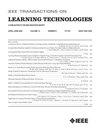How to Design Immersive Virtual Learning Environments Based on Real-World Processes for the Edu-Metaverse—A Design Process Framework
IF 2.9
3区 教育学
Q2 COMPUTER SCIENCE, INTERDISCIPLINARY APPLICATIONS
引用次数: 0
Abstract
Due to the rise of virtual reality and the—at least now—hypothetical construct of the如何为edu - meta - a设计过程框架设计基于现实世界过程的沉浸式虚拟学习环境
由于虚拟现实和虚拟世界的兴起,学习过程越来越多地转移到沉浸式虚拟学习环境中。虽然文献提供了很少的设计指南,但大多数论文都错过了设计和开发过程的应用和评估描述。因此,很少有标准化的设计过程和相关的设计框架能够有意义地整合现有的独立设计理论和开发沉浸式虚拟学习环境的最终方法。本文通过一个基于设计科学研究方法的研究过程来解决这一挑战,以概述和传达一个设计过程框架,从而为Edu-Metaverse创建基于现实世界过程的虚拟学习环境。简单适用的工件通过结合跨学科的透视图,代表了对定义良好的问题的全面的五步解决方案。它有助于将假想的术语“元宇宙”在其预期领域中具体化。因此,具有不同经验水平的从业者和研究人员可以使用低阈值框架。
本文章由计算机程序翻译,如有差异,请以英文原文为准。
求助全文
约1分钟内获得全文
求助全文
来源期刊

IEEE Transactions on Learning Technologies
COMPUTER SCIENCE, INTERDISCIPLINARY APPLICATIONS-
CiteScore
7.50
自引率
5.40%
发文量
82
审稿时长
>12 weeks
期刊介绍:
The IEEE Transactions on Learning Technologies covers all advances in learning technologies and their applications, including but not limited to the following topics: innovative online learning systems; intelligent tutors; educational games; simulation systems for education and training; collaborative learning tools; learning with mobile devices; wearable devices and interfaces for learning; personalized and adaptive learning systems; tools for formative and summative assessment; tools for learning analytics and educational data mining; ontologies for learning systems; standards and web services that support learning; authoring tools for learning materials; computer support for peer tutoring; learning via computer-mediated inquiry, field, and lab work; social learning techniques; social networks and infrastructures for learning and knowledge sharing; and creation and management of learning objects.
 求助内容:
求助内容: 应助结果提醒方式:
应助结果提醒方式:


